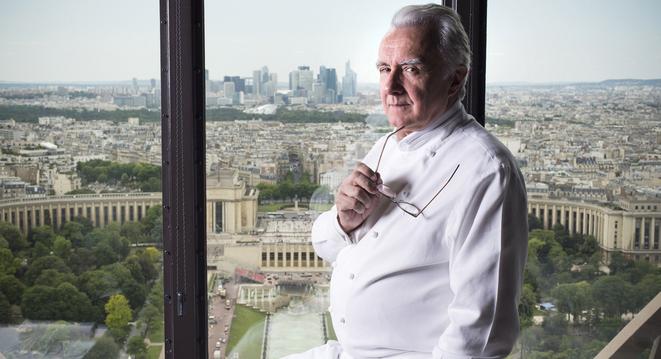
How Alain Ducasse wants to reclaim the Eiffel Tower
Chef Alain Ducasse in Jules Verne (LIONEL BONAVENTURE/AFP)
master chef of politics
The Jules-Verne, located on the second platform, 125 meters high, already enjoys a legendary aura thanks to its location, but the address is relatively recent. It was created in 1983. Until then, only a brasserie, installed 58 meters above the ground, after demolition of the rococo salons dating from the Universal Exhibition of 1889, entertained tourists. When Ducasse entered the scene, in 2007, the restaurants of the tower were, thanks to a concession granted by the town hall of Paris, under the leadership of chef Alain Reix, backed by the collective catering company Elior. Alain Ducasse has been associated for several years with a company that operates in the same sector, the French multinational Sodexo, owned by the Bellon family. He even became its consultant. Couplings between stars of high gastronomy and supplier groups of breaded fish in canteens. Faced with Sodexo, a world giant, Elior, with a turnover four times lower, does not measure up. The municipality does not renew its contract. Sodexo wins the concession for a period of ten years. And his foal, Alain Ducasse took possession of the Jules-Verne on January 1, 2007. His team did not hesitate to say that the predecessors left the place in a deplorable state, "infested with cockroaches and mice". Chef Alain Reix was quickly dismissed "for serious misconduct". He attacks the prud'hommes and wins his case. No matter: Ducasse and Sodexo erase it like a bad memory. The decor of the panoramic restaurant has been completely “redesigned”. Four months of work. “The most beautiful place in Paris”, according to its website, reopens its doors on Christmas Eve, December 24, 2007. Brown and cream walls and chairs, white plates with sleek graphics. One hundred and ten seats, distributed in three rooms. A total area of 330 m2, accessible by a single private elevator, located at the bottom of the south pillar, where cooking is complicated. Flames are prohibited, gas prohibited. Security reasons. It takes more to discourage Ducasse who has installed, under the Champs-de-Mars, what he calls a “laboratory”, accompanied by a cellar containing hundreds of references. An armada of small hands are busy there under the guidance of chef Pascal Féraud, a pure "Ducasse boy" who, in 2009, won a Michelin star, with the great classics learned from his mentor: crunchy vegetables (grown in the vegetable garden of the Palace of Versailles), venison, crayfish, golden scallops, Limousin lamb, Bresse poultry. "French cuisine reinterpreted with modernity, and the excellence of products from our regions", says Ducasse everywhere, like an ambassador. In fact, the Jules-Verne becomes, year after year, one of the essential stops for tourists with high purchasing power or rich and newlyweds on their honeymoon. It is on the shelves of tour operators who sell it with the destination Paris. Its occupancy rate is close to 100% every evening. After a decade of operation, its turnover has reached 20 million euros per year, with each seat bringing in, over the same period, 200,000 euros. The best “customer benefit” ratio of all Ducasse restaurants. To this must be added the income generated by the brasserie and the various fast food buffets in the Eiffel Tower, which double those of Jules-Verne. It is easy to understand why the Landais loves the "iron lady" so much. Who, moreover, could dislodge him?








